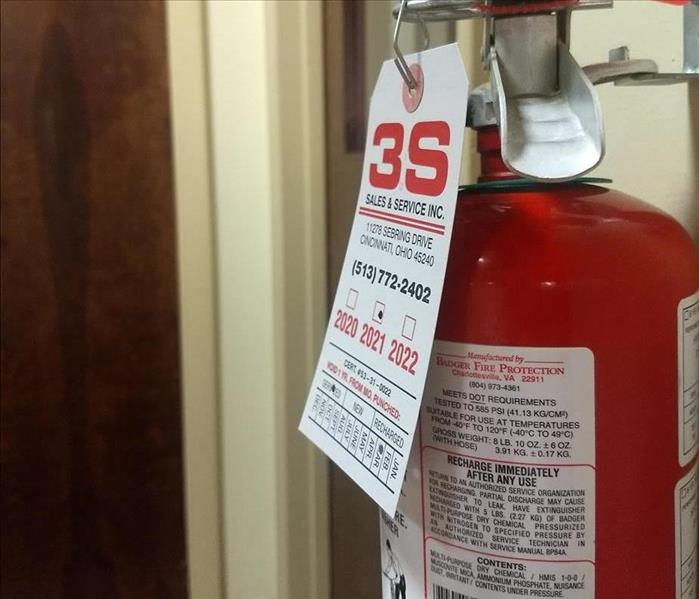Important Things to Know about Fire Extinguishers
3/17/2021 (Permalink)
Fire extinguishers are household items that everyone hopes they never have to use. Like most home and business owners, you probably bought it to protect your house from fire and put it out of your mind. In the unfortunate event that you do have to use it, it’s important to have some basic information about it. Continue reading for the types of fire extinguishers there are, where to find that information on the extinguisher you own, what types of fires they’re used for, and some basic cleaning/ safety instructions.
Types of Fire Extinguishers
There are 9 basic types of fire extinguishers. These different chemical compounds are used for the different types of fires homes and businesses can have.
Monoammonium Phosphate, Potassium Bicarbonate, & Sodium
These are the most common types of fire extinguishers that you will find. They work on Class AB&C fires. The University of Massachusetts Boston explains these classifications below:
Class A fires which involve "ordinary combustibles" such as wood, paper, cloth, rubber and many plastics.
Class B fires which involve flammable liquids, oils, greases, tars, oil-based paints and flammable gases.
Class C fires which involve energized electrical equipment.
For the most part, the chemicals in these extinguishers are nontoxic. However, they can be considered an eye, mucus membrane, and skin irritant. This is especially true for Monoammonium Phosphate. For this reason, it’s advisable to turn off the ventilation system, after it’s been used, so it doesn’t kick up the powder throughout the house. This also should not be cleaned up with vacuum cleaners.
Potassium Bicarbonate and sodium-based fire extinguishers are less of an irritant but should still be handled with caution. For these, you don’t have to turn off the ventilation system, and you can suck up the powder with a vacuum. Keep in mind a HEPA vac or shop-vac are the suggested types of vacuums to use.
It is important to clean up after these extinguishers quickly. The chemicals in these are often corrosive and could cause even more damage if left sitting.
Clean up is pretty simple and should you decide to do it yourself it can be done with common household items. Electrical outlets can be cleaned by using a can of pressurized air that would use to clean out your keyboard. Monoammonium Phosphate must be dry cleaned, to begin with. Sweep it up or wipe it away with a dry cloth or brush. Otherwise, the cleaning process is exactly the same. Use a paste made from baking soda and water. It’s a 1:1 ratio. Use a warm wet cloth to wipe up the remaining residue.
If the powder is stuck on there use a 1:1 ratio of 50% rubbing alcohol and water. Let the mixture sit for a bit then wipe it up as normal.
Class D fires
A Class D fire is defined as a fire started by combustible particulates. This could be metal shavings or dust from a bread mill. Fire extinguishers for these are usually filled with one of the following 4 chemicals and elements.
- Sodium Chloride
- Sodium Carbonate
- Copper
- Graphite
Be sure to steer clear of any vacuums for these cleanups. The static charge especially in graphite can make it combustible.
Wet Chemicals
Wet chemicals are usually used in commercial kitchen fires. It is really important that you call the professionals at SERVPRO after this type of fire. These chemicals are harmful and can cause damage to your nervous system and vital organs. After discharging these extinguishers you’ll want to make sure that the area is very well ventilated. If you have to go into the area make sure you are wearing N95 or N100 masks. A purifying respirator is also highly suggested.
Clean Agent
The final type of extinguisher is a clean agent. This is usually made from CO2 or Hetron. As a gas-based extinguisher, there isn’t much cleanup because it dissipates into the air. However, it’s still a good idea to clean and sanitize the affected areas.
What Kind of Fire Extinguisher do You Have?
It is mandatory that all fire extinguishers disclose what kind of chemicals they hold. If you look at the attached photo for instance you can see that ours is listed on the fire extinguisher itself under Contents. We have an Ammonium Phospate based extinguisher. Different brands may have different placements but in general, they should be in the same basic area.
SERVPRO has a lot of experience in cleaning up after fire extinguishers. We have all the tools and equipment to handle this daunting task. So, if you’ve had a fire and need the powder cleaned up give us a call at any time. We’ll be happy to provide you a free estimate and save you the headache of having to clean up after a fire extinguisher yourself.

 24/7 Emergency Service
24/7 Emergency Service
